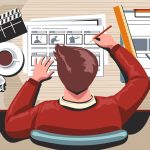Discover the role of a visual merchandiser, who curates captivating product displays within stores and retail windows to allure customers towards purchases. This article delves into the journey of becoming a visual merchandiser and helps you learn how to get into visual merchandising.
Continue reading to learn how to become a visual merchandiser with no experience, including steps to take, and gain insights into the art of crafting appealing retail environments.
Table of Content
What is a Visual Merchandiser?
Duties of a Visual Merchandiser
1. Influence Customer Journey
2. Engage Customers with Unique Product Displays
3. Showcase Store’s Brand
Required Skills for a Visual Merchandiser
1. Create New Ideas
2. Communicate
3. Understand Trends
4. Know Brands
5. Manage and Organize
6. Help Customers
6 Easy Steps to Become a Visual Merchandiser
1. Earning a Bachelor’s Degree
2. Getting Certified
3. Gaining Experience
4. Knowing the Craft
5. Choosing Career Options
Conclusion
What is a Visual Merchandiser?
A pivotal figure in the retail realm, a visual merchandiser holds the responsibility of enhancing the presentation of products and services, effectively highlighting their features and advantages. The art of visual merchandising aims to captivate, motivate, and entice customers, ultimately steering them towards making purchases. Additionally, these professionals contribute significantly to a company’s growth by fostering customer engagement, thus enhancing productivity and sales. Serving as an integral part of any retail team, a visual merchandiser crafts retail strategies that amplify the visual appeal of products and services. Their primary focus lies in boosting sales while contributing substantially to a brand’s overall aesthetics, ambiance, and identity. To excel in this role, you should possess the following skills:
- Effective Layout Communication
- Regular Layout and Display Refinement
- Strategic Lighting Implementation
- Integration of Technology
- Signage Enhancement
Becoming a proficient visual merchandiser involves understanding the dynamics of consumer behavior, aesthetics, and sales strategies, ultimately transforming the retail environment into an inviting and immersive space that drives both customer satisfaction and business success.
Duties of a Visual Merchandiser
The daily tasks of a visual merchandiser vary based on factors such as the employer’s size, project nature, and level of responsibility. Among the myriad of responsibilities that a visual merchandiser might undertake are:
- Optimize store layout and spatial utilization
- Arrange dress forms and displays creatively
- Craft lighting and color schemes for product presentations
- Guide sales departments in coordinating counter displays and garment racks
- Participate in strategic business planning sessions
- Provide timely feedback to buying teams and the head office
- Collaborate with promotional and marketing teams
- Organize display fixtures, showcases, counters, and clothing racks
- Present display concepts persuasively to marketers
- Monitor merchandise sales across all retail locations
The role of a visual merchandiser often entails traveling between retail locations and performing tasks from the central office. Depending on your employer and the specific store’s needs, you might even manage the visual aspects of a single store. Notably, some visual merchandisers leverage computer software to devise strategies aimed at captivating a larger customer base. Furthermore, visual merchandisers are integral in bringing merchandise designs to life in the physical realm. Succeeding as a visual merchandiser demands a flair for innovation to craft distinctive displays, counters, and various items that entice customers to engage with the company’s offerings. Among the additional responsibilities of visual merchandisers are:
1. Influence Customer Journey
In the age of online shopping, retail stores maintain their relevance, and visual merchandisers contribute by crafting displays that effectively showcase the company’s brands. As consumers continue to navigate both online and physical shopping avenues, the crucial initial step is capturing their attention. With captivating window displays, stores can draw in a larger customer base, and adept merchandising serves as a compelling strategy to encourage shoppers to explore and make purchases in-store. Visual merchandisers facilitate this by employing various techniques:
- Featured products
- Well-lit displays
- Curated products
- Limited color palette
- Appropriately sized props
2. Engage Customers with Unique Product Displays
Visual merchandisers employ an array of techniques to entice prospective customers into retail establishments, utilizing elements like signage, product displays, personal interaction, and innovative marketing tactics. These professionals strategically leverage the following essential components to captivate customers:
- Window Displays: Employed to effectively communicate design, content, style, and pricing messages, enticing potential buyers to step into the store.
- Floor Mapping: By crafting merchandise zones and hierarchies, they guide the placement of products on display windows, effectively drawing customers in through thoughtfully organized offerings within the store.
- Tables and Wall Fixtures: Utilizing these platforms to curate displays that create a memorable customer experience through appealing arrangements, well-chosen lighting, and creative spatial arrangements.
- Walls and Features: Engaging customers right from the moment they enter the store and navigate through various sections. This is achieved through strategically positioned fixtures, furniture, and visual communication elements such as photography and digital content, ensuring a seamless and captivating shopping journey.
3. Showcase Store’s Brand
Visual merchandisers hold the power to influence the ambiance, appearance, and identity of your merchandise brand. Their impact extends to fostering brand awareness and strengthening customer loyalty. By effectively captivating customers and guiding their shopping experience through meticulously designed displays, you have the opportunity to not only attract customers but also seal the deal. The aesthetic appeal of your merchandise display can be a decisive factor in captivating customers and driving sales. Successfully showcasing your brand not only enriches the customer journey but also translates to increased sales and positive feedback, creating a more memorable and satisfying shopping experience.
Required Skills for a Visual Merchandiser
1. Create New Ideas
Creativity stands as a cornerstone skill for thriving visual merchandisers. These professionals harness their immense design prowess to conceive compelling images and ideas for specific products or services. Through captivating product displays, they entice customers to embrace brand merchandise and make purchases from their stores.
2. Communicate
Adept visual merchandisers excel in communication, skillfully navigating interactions with both sellers and buyers. They keenly listen to the needs of retail establishments and craft strategies that seamlessly convey store messages to potential customers. Identifying crucial messages and skillfully encapsulating them within visual displays is their forte.
3. Understand Trends
Sustaining the allure and relevance of merchandising initiatives demands a keen awareness of evolving trends in visual merchandising. Professionals in this field proactively seek out the latest materials, encompassing models, signage, articles, equipment, and props that hold sway in the market. Utilizing their grasp of consumer preferences, they implement compelling visual merchandising strategies.
4. Know Brands
Central to the role of visual merchandisers is the art of promoting diverse store brands, services, and products. These experts craft distinctive store displays that beckon more customers and elevate sales. An intimate understanding of each brand empowers them to collaborate with store managers, marketing teams, and retail buyers to draw customers to the business.
5. Manage and Organize
Exceptional organizational skills form the bedrock of a visual merchandiser’s effectiveness, aiding in the seamless coordination and management of visual display projects. Collaborating with colleagues, supervisors, and subordinates, they orchestrate the implementation of intricate visual merchandising plans. This encompasses multifaceted tasks such as sourcing materials and supplies.
6. Help Customers
Gather customer input and exhibit exceptional customer service proficiency. Comprehend the intricacies of customer service strategies and methods that captivate potential buyers toward your store’s offerings. Engage with customers to discern their preferences and expectations, fostering a dialogue that reveals desired modifications in your store’s presentation. Through this interaction, you align your displays with customer preferences, enhancing engagement and fulfilling their expectations effectively.
6 Easy Steps to Become a Visual Merchandiser
If you’re aspiring to pursue a career as a visual merchandiser, take these factors into account:
1. Earning a Bachelor’s Degree
To access more advanced roles in visual merchandising, a bachelor’s degree can be advantageous. Four-year programs encompassing fields like exhibition design, fashion merchandise, and visual communication offer a solid foundation. Study areas like business administration, covering subjects such as merchandising, graphic design, marketing, and retail management. Courses tailored to the retail industry may delve into branding, textiles, psychology, purchasing, and graphical presentation.
2. Getting Certified
Earning relevant certifications can distinguish you as a proficient visual merchandiser. While working part-time, pursue certification or a diploma in visual merchandising. Accredited certifications furnish essential skills required for success in this field. Acquiring skills in digital design, color theory, art, drawing, and graphic design enhances your competence. Proficiency in areas like designing lighting and props for store displays is crucial.
3. Gaining Experience
Accumulating substantial experience is pivotal in a visual merchandiser’s journey, demanding a diverse skill set. Cultivate innovation to craft distinctive merchandise displays that entice customers. Begin as a sales associate in department stores or boutiques, progressively evolving into a seasoned visual merchandiser. This progression helps you grasp effective display designs and understand customer attraction tactics.
4. Knowing the Craft
Visual merchandisers shape product design prior to displaying merchandise on props and stands. Transcending initial drafts, they conceptualize store window and counter layouts. Developing skills in creative aspects like lighting, color schemes, banners, and layout is vital. Acquire the capacity to design compelling, realistic merchandise displays that resonate with customers.
5. Choosing Career Options
A bachelor’s degree opens doors to diverse visual merchandising roles. Opportunities exist in trade show organizations, hospitality, museums, theme parks, retail corporations, event sponsors, and furniture stores. Further education could lead to roles like store manager, fashion merchandiser, buyer, showroom manager, or interior designer, expanding your career prospects.
Conclusion
In conclusion, becoming a successful visual merchandiser involves a blend of creativity, communication, trend awareness, and brand understanding. Through meticulous planning, effective display strategies, and customer-centric approaches, visual merchandisers can captivate customers, enhance brand loyalty, and drive sales. By following the outlined steps, you can embark on a fulfilling journey in the dynamic world of visual merchandising, contributing to the allure and success of retail establishments.
























